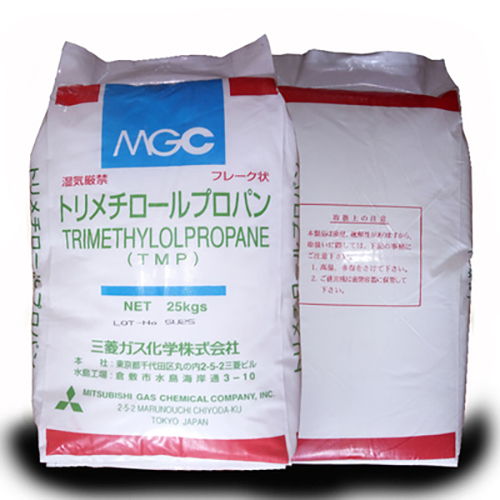Trimethylolpropane: Industrial Applications and Health Hazards
General Description
Trimethylolpropane is a versatile chemical widely used in industrial applications, particularly in the production of resins, coatings, and polyurethanes. It enhances the performance of alkyd and polyester resins, improving chemical resistance and flexibility, crucial for automotive and marine applications. Additionally, Trimethylolpropane serves as a polyol in polyurethane foams and elastomers, contributing to durability and temperature resistance. However, occupational exposure poses health risks, necessitating proper safety measures, including protective gear and training. While short-term effects may include mild irritation or burns, long-term health risks appear limited, although safe handling and storage are essential to prevent exposure to toxic fumes.

Figure 1. Trimethylolpropane
Industrial Applications
Application in Resin and Coatings Production
Trimethylolpropane is extensively utilized in the industrial sector, primarily in the production of various types of resins and coatings. Trimethylolpropane serves as a critical ingredient in the manufacture of alkyd resins, which are used extensively in synthetic paints and varnishes. The incorporation of Trimethylolpropane enhances the performance of these coatings by improving their chemical resistance and durability, making them suitable for both indoor and outdoor applications. Furthermore, Trimethylolpropane is vital in the formulation of polyester resins, which are key components in the production of fiberglass and other composite materials. These resins benefit from Trimethylolpropane's ability to impart enhanced flexibility and weatherability, critical factors in automotive and marine applications. 1
Role in Polyurethane Applications
Trimethylolpropane's functionality extends into the realm of polyurethane chemistry, where it is used as a polyol component. In this capacity, Trimethylolpropane contributes to the synthesis of polyurethane foams that are prevalent in automotive seats, insulation materials, and various comfort products. Trimethylolpropane 's unique chemical structure helps these materials withstand extreme temperatures and mechanical stress, which is crucial for maintaining their integrity and performance in demanding environments. Additionally, Trimethylolpropane is used as a crosslinking agent in the production of polyurethane elastomers and plastics, which are pivotal in creating durable and flexible products ranging from medical devices to industrial seals and gaskets. 1
Applications in Specialized Industrial Products
Beyond resins and polyurethanes, Trimethylolpropane finds significant use in the production of advanced industrial products. It plays a crucial role in the synthesis of synthetic lubricants and aviation lubricants, which require high-performance ingredients to maintain optimal functionality under extreme operational conditions. Trimethylolpropane is also involved in the formulation of printing inks and textile additives, where its hygroscopic properties help stabilize the final product against temperature-induced degradation. The broad applicability of Trimethylolpropane in these diverse industrial applications underscores its versatility and importance as a multifunctional chemical compound in modern manufacturing processes. 1
Health Hazards
Occupational Risks
Trimethylolpropane presents potential health hazards during occupational exposure, particularly in settings where it is manufactured, transloaded, or stored. Workers engaged in mixing or sampling operations face a higher risk due to the likelihood of inhalation or dermal contact with this chemical. The chance of exposure is significantly minimized in environments where trimethylolpropane is used in closed systems by trained personnel. However, to mitigate risks effectively, proper employee training is crucial. Workers must be educated on safe handling procedures and the inherent health and physical hazards associated with trimethylolpropane. Precautionary measures, such as the use of NIOSH-approved air-purifying particulate respirators, are recommended in poorly ventilated areas. Additionally, wearing protective goggles, permeation-resistant clothing, gloves, and foot protection is essential to reduce risks of exposure. 2
Short and Long-Term Concerns
While short-term exposure to trimethylolpropane can lead to mild health effects such as coughing from inhalation or thermal burns from contact with heated liquid, the potential for long-term health effects appears limited based on current data. There is no significant evidence indicating adverse chronic health effects due to overexposure to trimethylolpropane. However, contact with heated trimethylolpropane may cause more serious injuries due to thermal burns, and mechanical irritation can occur if the chemical comes into contact with the eyes. Generally, trimethylolpropane is stable under normal usage conditions and should be stored away from moisture and incompatible substances like nitric acid or strong oxidizers. Safety precautions are imperative, particularly during handling and storage, to prevent exposure to potentially toxic fumes that could be released upon decomposition at high temperatures. 2
Reference
1. National Center for Biotechnology Information (2024). PubChem Compound Summary for CID 6510, Trimethylolpropane.
2. Product Safety Assessment: Trimethylolpropane. LANXESS Energizing Chemistry. CAS Number: 77-99-6.
You may like
Related articles And Qustion
Lastest Price from Trimethylolpropane manufacturers

US $0.00/KG2025-04-21
- CAS:
- 77-99-6
- Min. Order:
- 1KG
- Purity:
- 98%min
- Supply Ability:
- 30tons/month

US $0.00/KG2025-04-21
- CAS:
- 77-99-6
- Min. Order:
- 1KG
- Purity:
- 99%
- Supply Ability:
- 10 mt



